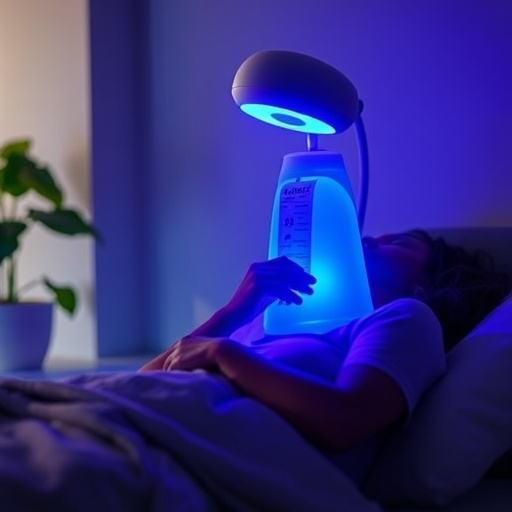In a groundbreaking study published in BMC Psychiatry, researchers have unveiled compelling evidence linking blue light therapy to significant improvements in psychiatric disorders through its effects on systemic inflammation and metabolic processes. This investigation offers a fresh perspective on the mechanisms underlying mental health treatments and opens promising avenues for adjunctive therapies that may revolutionize psychiatric care. The interplay between light exposure and immune-system modulation now takes center stage as a potential therapeutic pathway, challenging conventional paradigms that have long dominated psychiatric treatment.
Psychiatric disorders, ranging from depression to bipolar disorder, have historically posed complex challenges due to their multifactorial etiology and the limited efficacy of current treatment modalities. Traditional pharmacological and psychotherapeutic interventions, while beneficial for many, often leave a significant proportion of patients with residual symptoms or treatment resistance. Against this backdrop, the emerging interest in non-invasive modalities such as light therapy has intensified, particularly given light’s profound effects on circadian rhythms and mood regulation. Blue light, with its unique spectral properties, has recently garnered attention for its potent influence on neurological and immune functions.
The study in question conducted a retrospective analysis of 270 hospitalized patients diagnosed with a spectrum of psychiatric disorders. These patients received either standard treatment protocols or a combination of standard care supplemented with blue light therapy. Importantly, the research design accounted for seasonality, treatment duration, and the primary psychiatric diagnosis, providing a nuanced understanding of the therapy’s impact under varied clinical conditions. Such comprehensive stratification allowed the researchers to delineate the complex relationships that blue light exerts on biological and symptomatic dimensions of mental health.
One of the study’s most striking findings was the observed modulation of systemic inflammatory markers following blue light exposure. Psychiatric disorders have often been associated with elevated inflammatory cytokines and immune dysregulation, both of which can exacerbate symptom severity. The blue light therapy appeared to downregulate key inflammatory pathways, suggesting that part of its efficacy may stem from an anti-inflammatory effect. This insight aligns with burgeoning literature that regards psychiatric conditions, particularly depression, as neuroinflammatory diseases, thereby supporting the rationale for inflammation-targeted therapies.
Further adding depth to these findings was the documented influence of blue light therapy on lipid metabolism. Altered lipid profiles have been implicated in psychiatric morbidity, with disruptions in cholesterol and fatty acid metabolism believed to affect neuroplasticity and membrane fluidity, essential for normal neuronal function. The therapy was associated with measurable shifts in lipid metabolism, indicating a systemic metabolic recalibration that complements its immunomodulatory effects. This dual influence on immune and metabolic pathways underscores the sophisticated biological interplay mediated by blue light exposure.
Seasonal variations in treatment response emerged as another critical discovery. The study revealed that blue light’s effects on inflammatory markers and psychiatric symptoms were not uniform throughout the year but demonstrated marked fluctuations tied to seasonal changes. Such findings resonate with clinical observations of seasonal affective disorder (SAD) and underscore the need for timing considerations in employing light therapy. Seasonal stratification enriches the clinical applicability of these results by highlighting optimal periods or conditions for therapeutic intervention.
Clinically, the results denote a potential paradigm shift—blue light therapy could serve as an effective adjunctive treatment, augmenting existing pharmacological regimens. Its non-invasive nature and targeted biological effects present an attractive profile for integration into psychiatric practice, particularly for patients with inflammation-associated symptomatology or those unresponsive to medication alone. Additionally, the therapy’s safety and ease of administration could facilitate broader accessibility in both inpatient and outpatient settings.
The implications extend beyond mood disorders. Given the intricate relationships between systemic inflammation, lipid metabolism, and brain function, blue light therapy may hold promise for a range of psychiatric conditions characterized by immune dysregulation. This includes psychotic disorders and anxiety conditions, where inflammatory processes have been increasingly recognized as contributory factors. Tailoring blue light exposure protocols to specific diagnostic and biological profiles could optimize therapeutic outcomes.
Despite its promising results, the study underscores the necessity for further research to unravel the precise mechanisms by which blue light mediates its effects. Prospective, randomized controlled trials with larger cohorts and mechanistic biomarker analyses are essential to validate these findings and refine treatment parameters. Exploration into molecular signaling pathways, neuroimmune interfaces, and circadian biology will provide the mechanistic clarity that could drive therapeutic personalization.
The intersection of psychiatric disorders with systemic inflammatory processes exemplifies a burgeoning frontier in mental health research. By illuminating how environmental factors such as light can recalibrate immune and metabolic function, the study reframes therapeutic possibilities. This not only bridges gaps between psychiatry, immunology, and metabolism but also encourages holistic approaches that transcend traditional mind-body dualisms.
Furthermore, the integration of blue light therapy aligns with contemporary shifts toward precision medicine. Understanding individual patient profiles, including inflammatory status and metabolic parameters, could guide clinicians in optimizing light exposure regimens. Personalized protocols could mitigate adverse effects, enhance efficacy, and improve patient adherence, ultimately contributing to better long-term management of psychiatric disorders.
Overall, this pivotal study invigorates the discourse on innovative, biologically informed treatment modalities in psychiatry. The convergence of light therapy with immunometabolic modulation offers a novel lens through which to address the multifaceted nature of mental illness. As the scientific community advances toward unraveling the intricate choreography of systemic and neural factors, blue light therapy stands poised to become a transformative tool in the psychiatric arsenal.
The promising results presented herald a new horizon where non-pharmacological interventions, grounded in rigorous scientific inquiry, are harnessed to improve mental health outcomes. This research not only deepens our understanding of the biological underpinnings of psychiatric disorders but also exemplifies the potential of interdisciplinary approaches to reduce the global burden of mental illness.
Subject of Research:
Psychiatric disorders and the effects of blue light therapy on systemic inflammation, lipid metabolism, and clinical symptoms.
Article Title:
Blue light treatment of psychiatric disorders: relationships with systemic inflammation, lipid metabolism, and clinical symptoms.
Article References:
Ren, L. Blue light treatment of psychiatric disorders: relationships with systemic inflammation, lipid metabolism, and clinical symptoms. BMC Psychiatry 25, 1008 (2025). https://doi.org/10.1186/s12888-025-07247-8
Image Credits: AI Generated




